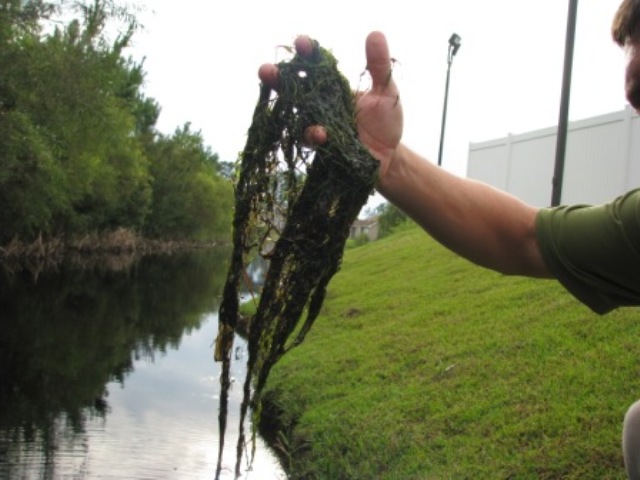A number of submerged plants flourish in stormwater ponds in South Carolina because these ponds are typically shallow enough that sunlight can penetrate all the way to the bottom. Stormwater ponds also receive repeated inputs of nutrients through runoff from lawns and roadways each time it rains. The combination of shallow water, sunlight and nutrients makes for the ideal habitat for submerged vegetation.
Submerged plants provide many ecological services, such as:
- oxygenation of the water
- shelter and forage for fish and invertebrates
- absorption of nutrients and pollutants
- moderation of water temperature
However, when submerged vegetation grows in excess, it also can cause problems, such as:
- impeded circulation and reducing the pond's ability to trap pollutants
- blocked pipes and conveyances
- vegetative decay and low oxygen which can lead to noxious odors and fish kills
- increased sedimentation and accelerating the time until the pond will need to be dredged
-
Should all submerged vegetation be removed from my pond?
No. Submerged vegetation is essential to protecting the ecological integrity of the aquatic environment.
-
Can too much algae become a problem?
Yes. There are a number of submerged plants that are extremely invasive and should be eliminated if possible. These include plants such as Hydrilla, Eurasian Watermilfoil, and Brazilian Elodea. These, along with several other plants, are illegal aquatic plants in South Carolina, making it against the law to possess, sell, or introduce these plants. View a list and descriptions of South Carolina's illegal aquatic plants.
-
How much submerged vegetation is too much?
Submerged vegetation should be restricted to the littoral zone (the shallow areas around the perimeter of the pond) because most cannot grow in depths greater than 4 feet. Submerged vegetation should be managed to prevent it from covering more than 20% of the pond, and it should be prevented from "topping out" (ie., reaching the water surface) where possible. Also, submerged plants should be managed around inlets and outfalls to prevent blockages.
-
What are the best ways to manage submerged vegetation?
Use Integrated Pest Management:
- Stock the pond with triploid grass carp. Triploid carp will consume most submerged plant types and will provide effective control for anywhere from 5 to 8 years before they need to be restocked. It is recommended that they be stocked at a rate of 20 fish per acre of vegetation if there is already a lot of weed growth. If not, they should be stocked at a rate of 5 to 10 fish per acre of pond to prevent excessive plant growth.
- Dredge to restore depth. As ponds fill with sediment they develop more submerged weed growth because sunlight is able to reach the bottom. Restoring depth to at least 4 feet will reduce the potential for submerged plant growth. Also, removing dredge spoils will remove the seed bed and root stock in the bottom of the pond that produces new plants. Before dredging, contact your county or municipal stormwater department for guidance (see Construction and Sedimentation).
- Harvest plants manually or mechanically. Physically removing submerged vegetation with rakes and other tool is effective at reducing plants but not eliminating them. Removing plants by hand works well for maintaining access points and keeping pipes open, but it is too costly and laborious for maintaining the entire pond. There are mechanical harvesters available for purchase which can make harvesting more economically feasible.
- Aquatic dyes can reduce the growth rate of submerged plants and can work when used in concert with grass carp. They must be applied before growth begins in the spring and maintained throughout the growing season. They do not work well in most stormwater retention ponds because the dye is diluted and flushed out of the system with each significant rain event (1" or greater), and they will not work in very shallow ponds.
- Contract with a lake management company to apply aquatic herbicides. Some submerged plants may elude control by other methods and will require chemical treatment. Aquatic herbicides are helpful tools for managing aquatic weeds, but they must be applied by licensed applicators when applying to stormwater ponds. For a list of applicators, look under "Lake Management" in the phonebook or ask for a list of licensed applicators from the SC Aquatic Plant Management Society.
- Plant beneficial wetland plants along shorelines to filter runoff, stabilize banks, and absorb nutrients. Shorescaped banks and floating wetlands can reduce the amount of nutrients available to submersed plants. See the section on shoreline management for more information.
- Educate your residents. Many invasive plants are introduced by well-meaning residents who toss water garden plants into ponds. Preventing introductions is important for avoiding invasive weed problems. Also, informing homeowners that nutrients from their daily activities (fertilizing lawns, car washing in driveways, pet waste, feeding ducks/fish/turtles, etc.) will accelerate the growth of submersed weeds will help reduce plant populations and water pollution in general.


